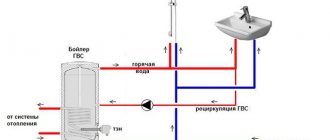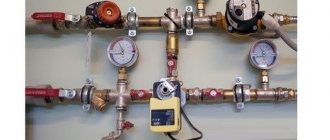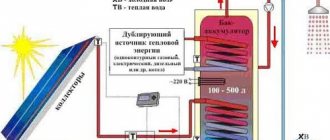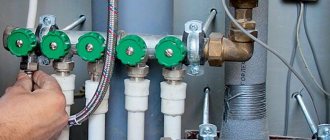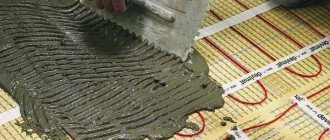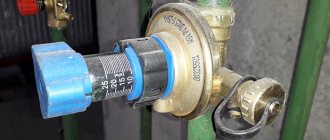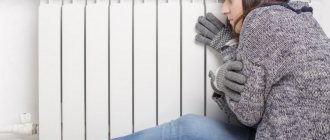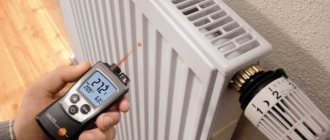Many modern residential apartments are equipped with autonomous heating. There is no question of norms here. Everyone sets the water temperature in the radiators as desired and pays according to the meter. However, most houses still have central heating, where the temperature in the radiators is regulated by regulations. When it gets cold in the apartment, people wonder what the normal temperature of the water in the central heating radiators is.
Radiators according to GOST standards
Legislation
- Federal Law No. 190-FZ dated July 27, 2010 “On Heat Supply” regulates relations in the field of heating residential buildings.
- Federal Law of December 7, 2011 No. 416-FZ “On Water Supply and Sanitation” in Article 7 of Chapter 3 contains general rules for heat supply of apartment buildings.
- Decree of the Government of the Russian Federation dated May 6, 2011 No. 354 “On the provision of utility services to owners and users of residential premises in apartment buildings” in Appendix 1 establishes requirements for the quality of heat provision (permissible breaks, conditions and procedure for changing fees, air temperature standards).
- GOST R 51617-2000 “Housing and communal services. General technical conditions" regulates the provision of standard levels of air heat.
- SP 60.13330 SNiP 41-01-2003 “Heating, ventilation and air conditioning”.
When heat depends on batteries
The heat supply is regulated by Decree of the Government of the Russian Federation No. 354 of May 6, 2011. According to this document, the start and end of heating is tied to the ambient temperature. The central heating radiators are turned on when the daily average drops 8 degrees above zero and lasts for five days. On the main territory of Russia this occurs by mid-October.
Battery under the window
Water leaves radiators when the average outdoor temperature reaches +8 degrees Celsius. And it remains so for five days. Battery shutdown times vary according to regulations.
In warm years this occurs at the end of April.
If the temperature is low, then according to the standards, heating of residential and industrial premises is maintained until mid-May. Only during this period of time should we talk about temperature standards for water in radiators. The rest of the time, fighting the cold is the job of the residents.
How to request a recalculation if you deviate from the temperature schedule
How is the payment for hot water recalculated if the temperature schedule for hot water supply is violated? Having a control measurement report in hand, confirmed by an official of the management company, you need to visit the management organization to arrange a recalculation of the hot water service.
If the DHW temperature at the time of measurement was ≤ 400C, then the DHW consumption must be paid, in accordance with the law, according to tariffs for cold water. Thus, to carry out an official recalculation, you need to have on hand a certificate of measuring the DHW temperature. Before drawing up the act, an application for measurement is submitted; the document must contain the registration number, the time of acceptance into office work, and the data of the dispatcher who accepted the application. If the report was drawn up during a technical failure, and subsequently the temperature of the hot water returned to normal, the dispatcher is obliged to notify the applicant about this, indicating the timing of emergency operation of the hot water and the time to repair the breakdown in the pipeline.
If the hot water temperature is constantly low and the reasons for this decrease are unclear, you should decide with a company representative (dispatcher) about the time to carry out a control measurement of the hot water temperature. After measuring and drawing up several copies of the act according to the number of participants in the measurement, the document is sent to the authorities that approve or do not approve the need for recalculation.
In winter, measurements are taken taking into account the outside temperature and the thermal insulation conditions of the hot water supply line.
Temperature graph summary for DHW heat supply
Normal water temperature
It was once believed that water for central heating should be heated to 100 degrees on the outlet and 60 degrees on the return flow. At that time there was no good equipment to control the heating of water for central heating. This approach is not cost effective. Rising fuel costs increase utility bills for homeowners.
Standard radiators
Modern equipment allows the use of low-temperature heating of apartments according to standards. This means that the water temperature standards in heating radiators are not constant. They become attached to external factors. The following are taken into account:
- Heat loss from buildings. It is theoretically possible to build a house without heat loss. To do this, you will need to cover it with insulation of at least a meter thick. In fact, 150 mm of high-performance insulation is considered good thermal insulation. But heat loss will still occur through the walls, floor and roof. The higher these losses, the more heating the home needs to create a comfortable environment.
- Heat source indicators. If the boiler does not meet the design requirements, then more heating of water for heating is required.
- Heat transfer from the metal from which pipes and batteries are made. If the metal of the pipes has low thermal conductivity, this will prevent heat loss during transportation from the heat source. Batteries, on the contrary, must have high thermal conductivity in order to transfer heat to the maximum. Cast iron batteries have lower thermal conductivity compared to aluminum and bimetallic ones. For equal heating, the water temperature must be higher in cast iron.
Installing a heating battery according to standards
When assessing the comfort of housing, the temperature in the heating system is not the main indicator. Temperature standards refer to the state of the apartment's atmosphere.
Free legal assistance
According to the Housing Code of the Russian Federation, the consumer pays for hot and cold water, energy spent on heating water, and water disposal (sewage). The total payment is calculated based on the readings of individual meters or communal meters. If neither one nor the other is available, then payments are accrued according to the standards. During the day, the indicators differ by 3 degrees, and at night up to 5. For every 3 degrees, a tariff reduction of 0.1% is required. Where should I contact? If deviations from the norms are noticed, then it is necessary to contact the housing and communal services. When the cause lies in an accident, the dispatcher will notify you about the duration of repair work. If there are no reasons for lowering the temperature, then you should draw up and submit an application. Consideration of public complaints is carried out quickly. To be sure that the application is considered, you need to write its number, as well as record the time of the call and the name of the person who accepted the complaint. If the person persists, measures must be taken to restore the water temperature. If it is no more than 40 degrees, then the tariff should be the same as for cold water supply. What to do if the water is of poor quality? The temperature is set according to SanPiN.
Pyrometer and how to work with it
A pyrometer is an infrared thermometer. It determines temperature by electromagnetic radiation. An accurate engineering device allows you to quickly measure the temperature of an object located at a distance not exceeding three meters from the device.
Heating standards
But even this excellent equipment is capable of producing errors, which is what negligent utility workers take advantage of. When measuring temperature, the device readings will be erroneous if:
- in a relatively small room there are many objects made from various materials;
- there is high humidity or a lot of dust in the room;
- the temperature of the device differs significantly from the room temperature;
- the distance to the measured object exceeds 3 m;
- the room is very large.
How to measure coolant temperature?
The temperature of the coolant in the heating system provides for the following standards:
- Hot water in the tap should be available all year round and its temperature should be from +50°C to +70°C;
- During the heating season, heating devices are filled with this liquid.
In order to find out the temperature of the heating radiator, you need to open the tap and place a container with a thermometer. At this time, the temperature may rise by 4°C.
When a problem arises in this matter, it is tedious to file a complaint with the Housing Office, but if the batteries are airy, the complaint is written to the DEZ. A specialist should come within a week to fix everything.
There are several more ways to measure the temperature of heating radiators in an apartment building:
- Using a thermometer, the temperature of the heating pipes or the radiators themselves is measured; 1 -2°C must be added to the result obtained;
- To measure data more accurately, you need to buy a thermometer-pyrometer that can measure temperature with an accuracy of 0.5°C;
- You need to take an alcohol thermometer and place it on a certain place on the radiator, then wrap it with tape and wrap it with any thermal insulator (foam rubber, flywheel). Now it will play the role of a permanent temperature meter of the heating system;
- In the case when you have an electronic measuring device at hand, for example, a multimeter, with a temperature measurement function, a wire with a thermocouple is wound to the radiator, and the temperature of the coolant is measured.
If you are not satisfied with the temperature of your heating devices or any other parameters of the coolant, then after filing a complaint a commission will come to you whose task will be to measure the temperature of the circulating fluid in the heating system.
They must strictly act in accordance with paragraph 4, which is specified in the “Control Methods” of GOST 30494−96, and the device must have registration, as well as verification and quality certificates. The measurement range should range from +5 to +40°C, the permissible error should be within 0.1°C.
conclusions
The legislator established standards for the characteristics of the heating system, paying special attention to the optimal temperature in the living room. Its value is the most important for residents, and it is also easy to check. If it is lower than required, it means the battery is not heated enough. And in case of non-compliance with the standards, you can file a complaint with the service organizations, not forgetting about recalculating the fee if it is discovered that heating services are of inadequate quality.
Lawyer. Member of the Bar Association of St. Petersburg. More than 10 years of experience. Graduated from St. Petersburg State University. I specialize in civil, family, housing, and land law.
What does temperature depend on?
There are several other factors that influence indoor temperature:
- If the air temperature outside is low, it will be lower indoors;
- Wind speed also has an impact on temperature. The stronger the wind loads, the greater the heat loss will be through windows and entrance doors;
- Tightness of sealing joints in the walls of the house. For example, metal-plastic windows and insulation of facade walls can significantly affect the temperature inside the home.
Everything described above is undoubtedly important. But the main factor that greatly influences the temperature in the rooms is the temperature of the heating radiators themselves. Typically, heating batteries powered from a central system have a temperature of 70 - 90°C.
It is known that the required temperature inside the room cannot be achieved by this factor alone, taking into account the fact that different rooms should have different temperature conditions due to their different purposes.
The temperature inside the room is also influenced by how intense the movement of people inside it is. Temperatures will be higher where people move the least.
This is the basis of heat distribution. As evidence, in sports facilities where people are constantly moving, the temperature is maintained at 18°C, since maintaining a higher temperature is not advisable.
Factors influencing the temperature of radiators:
- Outside temperature;
- Type of heating system. Standard for a one-pipe system: +105 °C, for a two-pipe system: +95 °C. The difference between supply and return should not be more than 105 - 70 °C and 95-70 °C, respectively;
- Directions for the flow of coolant into the batteries. In the case where the wiring is from above, the difference will be: + 20 °C, from below - +30 °C;
- Type of heating device. Radiators and convectors differ in heat transfer, which means that the temperature regime is also different. Convectors have lower heat transfer than radiators.
It is naturally clear to everyone that, regardless of whether it is a convector or a radiator, heat transfer will directly depend on the temperature outside. At zero street temperature, the heat transfer rate of radiators should vary within 40-45 °C supply and 30-35 °C return. For convectors, these characteristics are as follows: 41-49 °C supply and 36-40 °C return.
When the thermometer drops to -20 °C, these characteristics will be as follows: for radiators - supply 67-77 °C, return 53-55 °C, for convectors - supply 68-79 °C and return 55-57 °C. But when the thermometer reaches -40 °C, both radiators and convectors will have the same characteristics: supply 95-105 °C, return temperature 70 °C.
Air in the apartment
There are uniform standards that determine the heat index in a residential area. According to them, during the heating period the apartment must maintain the following temperature regime:
- In the living room - +18°C.
- In the corner living room - +20°C.
- In the bathroom at least +25°C.
- In the toilet (if located separately from the bathroom) - +18°C.
- If the bathroom is combined - + 25°C.
- In the kitchen at least +18°C.
The standards are established according to GOST. They are designed to preserve the health of residents. Common premises also have their own standards. The indicators should be:
- Entrance — +16°С.
- Elevator - +5°C.
- Attic and basement - +4°С.
If the actual parameters do not meet the standards, you should contact the heating network. These circumstances make it possible to reduce heating payments by 0.15% for each hour of deviation.
How are standards calculated?
As described above, the temperature graph is directly affected by the outside air temperature. Accordingly, the lower the temperature outside, the greater the heat loss. The question arises, what indicators should be used for the calculation?
This indicator can be found in regulatory documents. It is based on the average temperature of the five coldest days of the year. A period of 50 years is taken into account and the 8 coldest winters are selected. For what reasons is the average daily temperature calculated in this way?
Firstly, thanks to this, it is possible to be prepared in winter for low temperatures, which occur once every few years. In addition, taking these indicators into account, you can significantly save on costs during the creation of heating systems. In the case of mass construction, this amount will be very significant.
Accordingly, the temperature of the coolant will directly affect the temperature of the heated room.
Based on the street temperature indicators, the coolant temperature is calculated and has the following values:
Using the data from the table, you can easily determine the temperature of the coolant in the heating system of a panel house. You just need to use a thermometer to measure the temperature of the coolant during drainage from the batteries. The data in the 5th and 6th columns are the supply indicators, the 7th column is the return indicator. Please note that the first three columns indicate the temperature of the coolant at the inlet, i.e. excluding losses on heating mains.
The basis for recalculation of heating costs may be a discrepancy between the standard and actual coolant temperatures. In addition, you can install a meter, but all apartments in your house must be connected to central heating. These devices must be checked every year.
Thus, comfortable living in a high-rise apartment, in a country house or in a cottage directly depends on the arrangement of the heating system in the room. To do this, you need to know the most favorable temperature of the coolant in order to create as much comfort as possible in your home.
All special parameters are in various regulatory documents; if, for some reason, they are violated or not met, the Housing Office must consider the complaint or application and carry out appropriate control of all work to correct this misunderstanding.
Heat supply requirements
According to the above-mentioned Resolution, central heating is launched after 5 days, during which the average outside air temperature does not exceed +8 °C. If after 4 cold days it becomes warm again on the fifth, the start of the heating period is delayed until the specified conditions are met. Heating standards stipulate that stopping heating occurs according to the same principle: 5 days must pass with an average daily temperature of +8 °C.
The Decree contains changes that provide for an individual approach to the supply of heat to buildings that fully comply with the requirements for thermal insulation. Heating supply organizations are required to turn on the heating of such houses as soon as the outside temperature drops to the value specified in the design documentation. It is not difficult to guess that in reality these changes are not being carried out very well, and the start of heat supply occurs simultaneously in all residential buildings - insulated and ordinary.
During the heating season, the centralized heating system must provide multi-apartment residential buildings with a sufficient amount of thermal energy. In order for the heat supply service to be considered fully provided, the following requirements for permissible air temperature in premises for various purposes must be met:
- living rooms - from 18 to 24 °C, corner rooms - from 20 °C;
- bathroom (or separate toilet and bathroom) - from 18 to 26 °C;
- kitchen (taking into account the heat source in the form of a stove) - from 18 to 26 ° C;
- pantry - from 12 to 22 °C;
- corridor - from 16 to 20 °C.
For apartment buildings located in cold northern regions, the lower limit of permissible temperature in living rooms is increased to +20 °C (in corner rooms up to +22 °C). The increase comes into force provided that the frost outside reaches -31 °C (on average per day) and lasts for at least 5 days. It is also allowed to decrease the temperature in the apartment by 3 °C from midnight to 5.00 am.
The heat supply to a number of apartments or the building as a whole may be interrupted as a result of an emergency and unforeseen repairs. But regulatory documents allot a certain time for carrying out repair work, depending on weather conditions. The colder the outside air, the sooner the relevant service must repair the fault. The total duration of interruptions in heating operation is no more than 24 hours per month.
Adjustment features
The parameters of heating routes are the responsibility of the management of thermal power plants and heating networks. At the same time, housing office employees are responsible for the network parameters inside the building. Mostly, residents' complaints about the cold concern deviations to the lower side. Much less common are situations where measurements inside thermal units indicate an increased return temperature.
There are several ways to normalize system parameters that you can implement yourself:
- Reaming the nozzle. The problem of lowering the temperature of the liquid in the return can be solved by expanding the elevator nozzle. To do this, you need to close all the gates and valves on the elevator. After this, the module is removed, its nozzle is pulled out and drilled out 0.5-1 mm. After assembling the elevator, it is started to bleed air in the reverse order. It is recommended to replace the paronite seals on the flanges with rubber ones: they are made to the size of the flange from a car inner tube.
- Silence the suction. In extreme cases (during the onset of extremely low frosts), the nozzle can be completely removed. In this case, there is a danger that the suction will begin to act as a jumper: to prevent this, it is turned off. For this, a steel pancake with a thickness of 1 mm is used. This method is emergency, because this can cause a jump in battery temperature to +130 degrees.
- Difference control. A temporary way to solve the problem of temperature rise is to adjust the differential with an elevator valve. To do this, it is necessary to redirect the DHW to the supply pipe: the return pipe is equipped with a pressure gauge. The inlet valve of the return pipeline is completely closed. Next, you need to open the valve little by little, constantly checking your actions with the readings of the pressure gauge.
A simply closed valve can cause the circuit to stop and defrost. A reduction in the difference is achieved due to an increase in return pressure (0.2 atm/day). The temperature in the system must be checked every day: it must correspond to the heating temperature schedule.
How does a heating regulator work?
A regulator is a device that provides automatic control and adjustment of the temperature parameters of the coolant circulating in the heating system.
It consists of the following nodes and elements:
- Computing and switching unit;
- Actuator on the coolant supply line;
- An actuator for mixing water from the return line (sometimes a three-way valve is used and then they are combined);
- Boost pump on the “cold bypass” line (not always);
- Booster pump on the supply line;
- Shut-off fittings and valves;
- Coolant supply sensor;
- Return sensor;
- Outside air temperature sensor;
- Sensor (sensors in several places) room temperature;
The last two positions can be used either together or instead of each other, depending on how the heating schedule is set.
Now let's figure out how the control processes actually occur, how the regulator works.
Main elements of the temperature control system
The coolant temperature at the outlet of the heating system (return) depends on the volume of water passing through it, since the load is relatively constant. Therefore, the regulator, covering the water supply, increases the difference between the supply and return to the required value (sensors are embedded in these pipelines), to the required value.
If, on the contrary, it is necessary to increase the flow, then a booster pump is installed into the heating system, which is also controlled by the regulator. To lower the temperature of the incoming flow, the so-called “cold bypass” is used - part of the water circulated through the system is again sent to the inlet.
Thus, by redistributing flows depending on the data collected by the sensors, the regulator ensures a strict temperature schedule for the heating system.
One of the Vailant regulator block models
Often the heating controller is combined with a DHW controller using one computing unit. The hot water regulator is much simpler in terms of control and actuators. Using a sensor on the hot water supply line, the passage of coolant through the boiler is adjusted, and the stable 50 degrees required by the standard is ensured.
Maximum battery heating level
But the maximum standard water temperature in central heating radiators is prescribed in SNiP 41-01-2003 “Heating, ventilation and air conditioning”.
According to this document, the standards are as follows:
- the temperature maximum for water in apartment radiators is 95 ℃ with a two-pipe heating distribution;
- for single-pipe wiring, the maximum temperature is 115 ℃;
- The recommended heating value for the coolant is in the range of 85-90 ℃, since when it reaches 100 ℃, water boils, and to prevent this, special substances are added to it.
It is worth noting that at the maximum threshold of the normal water temperature in the heating battery of 115 ℃, they work with increased load and fail quite quickly. Therefore, operating the equipment in this mode is not recommended.
Devices
The most convenient and reliable is a portable infrared pyrometer with an accuracy class of 0.5. It takes readings remotely. That is, it is enough to point the bell at the surface to measure and record the value.
It is important that all measuring instruments, the readings of which will be used for complaints to government authorities and legal proceedings, must be operational and accurate. This can be confirmed by having them verified once a year by an accredited organization.
Thermometer
Without a pyrometer, you can check the heat transfer with a regular thermometer. To do this, you need to attach it with a flask to the battery, secure it with tape, and wrap it with heat-insulating material.
Calculation of the optimal temperature of the heating device
The most important thing is that the most comfortable temperature for human existence is +37°C.
When choosing a radiator, you need to calculate whether the thermal power of the device is enough to heat the room. There is a special formula for this:
S*h*41:42,
- where S is the area of the room;
- h – room height;
- 41 – minimum power per 1 cubic m S;
- 42 – nominal thermal conductivity of one section according to the passport.
Please note that a radiator placed under a window in a deep niche will produce almost 10% less heat. A decorative box will take 15-20%.
When you use a radiator to maintain the desired temperature in a room, you have two options: you can use small radiators and increase the water temperature in them (high temperature heating) or install a large radiator, but the surface temperature will not be as high (low temperature heating) .
With high temperature heating, radiators are very hot and can cause burns if you touch them. In addition, at a high temperature of the radiator, the decomposition of dust settled on it may begin, which will then be inhaled by people.
When using low temperature heating, the appliances are slightly warm, but the room is still warm. In addition, this method is more economical and safe.
Cast iron radiators
The average heat output of a separate section of a radiator made of this material ranges from 130 to 170 W, due to the thick walls and large mass of the device. Therefore, it takes a lot of time to warm up the room. Although this also has the opposite advantage - high inertia ensures long-term retention of heat in the radiator after the boiler is turned off.
The coolant temperature in it is 85-90 °C
Aluminum radiators
This material is lightweight, easily heats up and has good heat dissipation from 170 to 210 watts/section. However, it is susceptible to the negative effects of other metals and may not be installed in every system.
The operating temperature of the coolant in the heating system with this radiator is 70°C
Steel radiators
The material has even lower thermal conductivity. But due to the increase in surface area with partitions and ribs, it still heats well. Heat output from 270 W is 6.7 kW. However, this is the power of the entire radiator, and not of its individual segment. The final temperature depends on the dimensions of the heater and the number of fins and plates in its design.
The operating temperature of the coolant in the heating system with this radiator is also 70°C
So which one is better?
It will probably be more profitable to install equipment with a combination of the properties of an aluminum and steel battery - a bimetallic radiator. It will cost you more, but it will also last longer.
The advantage of such devices is obvious: if aluminum can withstand the temperature of the coolant in the heating system only up to 110°C, then bimetal can withstand up to 130°C.
Heat transfer, on the contrary, is worse than that of aluminum, but better than that of other radiators: from 150 to 190 W.
Warm floor
Another way to create a comfortable temperature environment in the room. What are its advantages and disadvantages over conventional radiators?
From a school physics course we know about the phenomenon of convection. Cold air tends to fall, and when it warms up, it rises. That’s why, by the way, my feet get cold. A warm floor changes everything - the heated air below is forced to rise upward.
This coating has a high heat output (depending on the area of the heating element).
The floor temperature is also specified in SNiP-e (“Building Norms and Rules”).
In a permanent home it should not be more than +26°C.
In rooms for temporary stay of people up to +31°C.
In institutions where children are taught, the temperature should not exceed +24°C.
The operating temperature of the coolant in the underfloor heating system is 45-50 °C. Surface temperature averages 26-28°C
Comments 1
Andrey
12/13/2017 at 07:51 | #
Dear Sirs! I purchased convectors built into the window sill in the fall through dealers - 3 pieces (one 3m, the other 2 1.2m each). I installed them in a window sill with a depth of 50 cm, the heating season began and it turned out that they did not even heat up. We have a townhouse of 4 floors, I live on the fourth, there is supposed to be another 5th floor, there is a boiler, heated with coal. I have water heating in the floor. The floor is warm enough, but as for convectors, they are slightly warm and therefore do not cut off cold air. The temperature in the comb reaches a maximum of 51 degrees, and as your dealers explained to me, that this temperature is not enough for a convector, a minimum of 70 degrees is needed, but unfortunately, if our boiler supplies 80 degrees, then it will be very hot in the lower floors. In this regard, I wanted to ask your opinion about what can be done in my case. Can he get convectors and replace them with electric ones, although the repairs have already been done? Then how much more expensive will it be when paying an electricity bill? Is it possible to install an electric boiler on convectors, although I have very little space in the boiler room, and how much will the electricity bill increase? maybe just install wall radiators? Don't get me wrong, I was advised to install built-in convectors in the window sill, since the window sill is deep, and I, in turn, refused wall-mounted radiators. At the moment, my convectors are not heating and there are no radiators, which, you must agree, is very disappointing. I am writing to you in the hope of an answer and help. Thank you.
Let's assume that the coolant in the riser complies with building code standards. It remains to find out what the normal temperature of the heating radiators in the apartment is. The indicator takes into account:
- outdoor air parameters and time of day;
- location of the apartment in the house plan;
- living or utility room in an apartment.
Therefore, attention: it is important not what the temperature of the heater is, but what the temperature of the air in the room is. During the day, in corner rooms the thermometer should show at least 20 °C, and in centrally located rooms 18 °C is allowed. At night, the air in the home is allowed to be 17 ° C and 15 ° C, respectively.
Theory of linguistics The name “battery” is a common one, meaning a number of identical objects. In relation to home heating, this is a series of heating sections. Temperature standards for heating radiators allow heating no higher than 90 °C. According to the rules, parts heated above 75 ° C are protected
At night, air in the home is allowed to be 17 °C and 15 °C, respectively. Theory of linguistics The name “battery” is a common one, meaning a number of identical objects. In relation to home heating, this is a series of heating sections. Temperature standards for heating radiators allow heating no higher than 90 °C. According to the rules, parts heated above 75 °C are protected.
